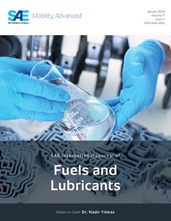Improvement of Performance and Reduction of Exhaust Emissions by Pilot-Fuel-Injection Control in a Lean-Burning Natural-Gas Dual-Fuel Engine
- Event
- Content
- The purpose of this study is to determine a pilot injection control strategy for the improvement of dual-fuel combustion with a lean natural gas/air mixture. Experiments were performed using a single cylinder test engine equipped with a common-rail injection system. The injection pressure, timing and quantity were varied at a fixed overall equivalence ratio of 0.5. The results of single-stage-injection experiments show that middle injection timings (−20 to −10 degATDC) produce low emissions of unburned species, because the pilot-fuel vapor spreads into the natural-gas lean mixture and raises the effective equivalence ratio, which leads to fast flame propagation. Early injection (−35degATDC) is advantageous for low NOx emission; however, increased emissions of unburned species are barriers. Two-stage pilot injection offers improved thermal efficiency and reduced exhaust emissions when early first-stage injection (−45 to −40degATDC) and moderately early second-stage injection are selected. Analysis of the heat release rate data indicates that the second injection controls the start of heat release, while the first-stage injection affects the overall flame propagation speed. Increased ratio of the first-stage injection quantity is useful for low hydrocarbon (HC) and NOx emissions with high thermal efficiency.
- Pages
- 11
- Citation
- Ishiyama, T., Kang, J., Ozawa, Y., and Sako, T., "Improvement of Performance and Reduction of Exhaust Emissions by Pilot-Fuel-Injection Control in a Lean-Burning Natural-Gas Dual-Fuel Engine," SAE Int. J. Fuels Lubr. 5(1):243-253, 2012, https://doi.org/10.4271/2011-01-1963.
